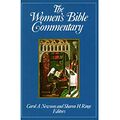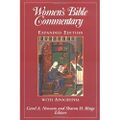Difference between revisions of "Category:OT Apocrypha (subject)"
| Line 13: | Line 13: | ||
The corpus of the OT Apocrypha or Deuterocanici (Tobit, Judith, Ben Sira, Wisdom of Solomon, 1-2 Maccabees, Baruch, plus the additions to Daniel and Esther) owes its existence to the polemics of the Reformation era and was sanctioned by the Council of Trent in 1546. | The corpus of the OT Apocrypha or Deuterocanici (Tobit, Judith, Ben Sira, Wisdom of Solomon, 1-2 Maccabees, Baruch, plus the additions to Daniel and Esther) owes its existence to the polemics of the Reformation era and was sanctioned by the Council of Trent in 1546. | ||
The Protestant reformers | The Protestant reformers acknowledged only the books also found in the Rabbinic Canon or [[Hebrew Bible]] as inspired scripture in the Old Testament. The Council of Trent reacted by affirming the larger canon of the traditional Roman Catholic Church, based on the Latin [[Vulgate]]: “If any one receive not, as sacred and canonical, the said books entire with all their parts, as they have been used to be read in the Catholic Church and as they are contained in the old Latin Vulgate . . . let him be anathema.” | ||
The Tridentine canon was identical to the list issued by the Council of Hippo (339 CE), except that the Council Fathers appear to have misunderstood the meaning of 1 and 2 Esdras, which they identified as the proto-canonical books of Ezra and Nehemiah with the exclusion of 2 Esdras (=4 Ezra). | Both groups could claim the authority of [[Jerome]] who had translated into Latin the books of the [[Hebrew Bible]] plus some additional books labeled as apocryphal in his prefaces. The Protestant interpreted strictly the principle of ''Hebraica veritas'' enunciated by Jerome, while the Tridentine Fathers relied on a long if not entirely consistent tradition of interpreters, including Augustine, which had came to consider "canonical" also Jerome's "apocryphal" books. The Tridentine canon was identical to the list issued by the Council of Hippo (339 CE), except that the Council Fathers appear to have misunderstood the meaning of 1 and 2 Esdras, which they identified as the proto-canonical books of Ezra and Nehemiah with the exclusion of 2 Esdras (=4 Ezra). | ||
This different approach resulted in a different treatment of the material within the Protestant and the Catholic tradition. | This different approach resulted in a different treatment of the material within the Protestant and the Catholic tradition. | ||
| Line 31: | Line 31: | ||
==== The Canonical Status OT Apocryphal Texts before the 16th century ==== | ==== The Canonical Status OT Apocryphal Texts before the 16th century ==== | ||
Before the 16th century the OT Apocrypha or Deutocanonici did not exist as a distinctive corpus, but were part of a "gray area" made of a larger amount of books that were more or less authoritative, or authoritative for some Second Temple Jews but not for others, and then for some Christians but not for others. Like many other texts now in the [[OT Pseudepigrapha]], the texts now in the [[OT Apocrypha]] were at the fringes of ancient Jewish and Christian canons, sometimes being considered authoritative, sometimes rejected. As they did not exist as a distinctive group any discussion must be | Before the 16th century the OT Apocrypha or Deutocanonici did not exist as a distinctive corpus, but were part of a "gray area" made of a larger amount of books that were more or less authoritative, or authoritative for some Second Temple Jews but not for others, and then for some Christians but not for others. Like many other texts now in the [[OT Pseudepigrapha]], the texts now in the [[OT Apocrypha]] were at the fringes of ancient Jewish and Christian canons, sometimes being considered authoritative, sometimes rejected. As they did not exist as a distinctive group any discussion must be | ||
==References== | ==References== | ||
Revision as of 13:19, 16 May 2013
The Old Testament Apocrypha, or Deutocanonici is a Christian collection generated in the 16th century to denote a certain group of Second Temple Texts not included in the Hebrew Bible and in the Protestant Canon but deemed "canonical" by the Roman Catholic Church since they were preserved in the Vulgate. Their canonicity is disputed among Christians.
- Deuterocanonical = Book of Tobit / Book of Judith / Esther Additions / Wisdom of Solomon / Book of Sirach / 1 Baruch and the Letter of Jeremiah / Daniel Additions (Prayer of Azariah and Song of the Children; Susanna; Bel and the Dragon) / 1 Maccabees / 2 Maccabees
Overview
The corpus of the OT Apocrypha or Deuterocanici (Tobit, Judith, Ben Sira, Wisdom of Solomon, 1-2 Maccabees, Baruch, plus the additions to Daniel and Esther) owes its existence to the polemics of the Reformation era and was sanctioned by the Council of Trent in 1546.
The Protestant reformers acknowledged only the books also found in the Rabbinic Canon or Hebrew Bible as inspired scripture in the Old Testament. The Council of Trent reacted by affirming the larger canon of the traditional Roman Catholic Church, based on the Latin Vulgate: “If any one receive not, as sacred and canonical, the said books entire with all their parts, as they have been used to be read in the Catholic Church and as they are contained in the old Latin Vulgate . . . let him be anathema.”
Both groups could claim the authority of Jerome who had translated into Latin the books of the Hebrew Bible plus some additional books labeled as apocryphal in his prefaces. The Protestant interpreted strictly the principle of Hebraica veritas enunciated by Jerome, while the Tridentine Fathers relied on a long if not entirely consistent tradition of interpreters, including Augustine, which had came to consider "canonical" also Jerome's "apocryphal" books. The Tridentine canon was identical to the list issued by the Council of Hippo (339 CE), except that the Council Fathers appear to have misunderstood the meaning of 1 and 2 Esdras, which they identified as the proto-canonical books of Ezra and Nehemiah with the exclusion of 2 Esdras (=4 Ezra).
This different approach resulted in a different treatment of the material within the Protestant and the Catholic tradition.
The first Protestant collection of OT Apocrypha by Taverner in 1549 published as a separated corpus texts originally printed as part of the Old Testament (from the 1939 Taverner's Bible) and included the apocalyptic 4 Ezra
On the other hand, the major Roman Catholic commentary of the 16th century, the Biblioteca Magna by Sixtus of Siena included these texts (with the exception of 4 Ezra) in the Old Testament, only by giving them the label of deuterocanonici in recognition of the fact that their canonicity was disputed.
While the Protestant tradition downplayed the religious importance of the OT Apocrypha, the Catholic tradition saw in them the canonical foundation of some distinctive Catholic doctrines such as the legitimacy of Church's property (see Expulsion of Heliodorus from the Temple) or the practice of intercession for the dead (see Judas' Prayer for the Dead).
This distinction in the treatment of the material within the Protestant and Catholic traditions has shaped the foundations of modern research; see OT Apocrypha Studies.
One of the first major consequences of the birth of the corpus of the OT Apocrypha / Deuterocanonici was the gradual emergence (since the beginning of the 18th century) of the companion corpus of the OT Pseudepigrapha (which Catholics called OT Apocrypha) to collect all the many other ancient books that before the 16th century had shared with the OT Apocryphal texts the same destiny of being at the fringes of the ancient Jewish and Christian canons.
The Canonical Status OT Apocryphal Texts before the 16th century
Before the 16th century the OT Apocrypha or Deutocanonici did not exist as a distinctive corpus, but were part of a "gray area" made of a larger amount of books that were more or less authoritative, or authoritative for some Second Temple Jews but not for others, and then for some Christians but not for others. Like many other texts now in the OT Pseudepigrapha, the texts now in the OT Apocrypha were at the fringes of ancient Jewish and Christian canons, sometimes being considered authoritative, sometimes rejected. As they did not exist as a distinctive group any discussion must be
References
- Apocrypha, Old Testament / Daniel J. Harrington / In: The Eerdmans Dictionary of Early Judaism (2010 Collins / Harlow), dictionary, 348-351
- / [[]] / In: The Anchor Bible Dictionary (1992 Freedman), dictionary,
External links
Pages in category "OT Apocrypha (subject)"
The following 16 pages are in this category, out of 16 total.
1
- Kurzgefasstes Exegetisches Handbuch zu den Apokryphen des Alten Testamentes (1851-60 Weidmann, Hirzel), book series
- Geschichte der althebräischen Litteratur (History of Ancient Hebrew Literature / 1906 Budde, Bertholet), book
- Talmud and Apocrypha (1933 Herford), book
- The Story of the Apocrypha (1939 Goodspeed), book
- (+) The Interpreter's One-Volume Commentary on the Bible (1971 Laymon), edited volume
- The Shorter Books of the Apocrypha (1972 Dancy), book
- La Bibbia delle donne: un commentario = The Women's Bible Commentary (1996-99 @1992 Newsom, Ringe / Franzosi), edited volume (Italian ed.)
2
- International Society for the Study of Deuterocanonical and Cognate Literature (2002-), learned society
- Commentaries on Early Jewish Literature (2003- de Gruyter), book series
- Deuterocanonical and Cognate Literature Yearbook
- Kuyak Sŏngsŏ ŭi oegyŏng immun (2004 Harrington / Pak), book (Korean ed.)
- International Conference on the Deuterocanonical Books (2004-), learned society
- Deuterocanonica (2004- L'Harmattan), book series
- Deuterokanonikus bibliai könyvek
- Deuterocanonical and Cognate Literature Studies (2008- de Gruyter), book series
- Political Power and Ideology in Early Jewish and Early Christian Literature (2011), conference
Media in category "OT Apocrypha (subject)"
The following 4 files are in this category, out of 4 total.
- 1795 * Eichhorn.jpg 307 × 400; 25 KB
- 1992-E * Newsom Ringe.jpg 475 × 475; 26 KB
- 1998-E * Newsom Ringe.jpg 500 × 500; 26 KB
- 2012-E * Newsom Ringe Lapsley.jpg 334 × 499; 31 KB



